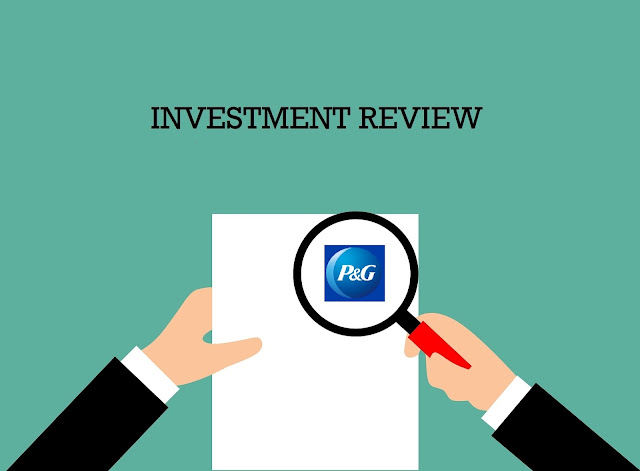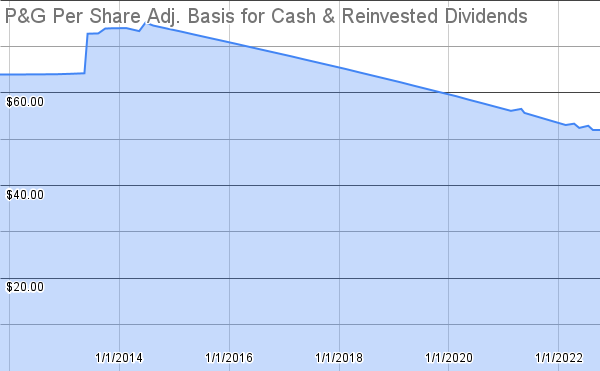Investment Review - Procter & Gamble $PG
I've been investing in individual companies for over a decade now. Honestly, it still seems like just a few years ago that I nervously made my first purchase of an individual stock.
I've made plenty of good decisions and my fair share of poor ones, but anyone that bats 1.000 with investing is lying to you.
In case you don't know the investment style that I follow is as a long-term dividend growth investor. As such I believe that it's good occasionally review your investments as well as their results.
While I typically done these reviews internally, I felt that it was probably best to share my thoughts on my investments as a way of thinking out loud. Over time I plan to recap my investments that have at least 5+ years since the date of my first investment in order to see what's gone right or wrong.
Overview
Procter & Gamble needs no introduction for dividend growth investors. They're one of the most well-known of the dividend growers and for good reason.
Procter & Gamble operates in the consumer staples sector designing, producing, manufacturing and selling goods that people use every single day. Consumer staples are one of my favorite sectors for dividend growth investments because they naturally lead to recurring revenue since their products are consumed by their users and need replacing.
Procter & Gamble has a bevy of brands that are very well recognized. Brand names such as Tide, Gain, Downy, Bounty, Charmin, Pampers, Gillette, Old Spice, Dawn, Febreze, Crest, and the list goes on and on. I'd venture to guess that if you look around your house you likely have several of Procter & Gamble's products. I know we do!
I first purchased shares of Procter & Gamble in November 2011 just we're coming up on 11 years of ownership since that first purchase.
Procter & Gamble was one of my very first purchases and since I was still testing the waters I purchased a small stake of just $639.45. As I learned more and became more comfortable with investing, purchases eventually came in bigger chunks throughout 2013-14. The small stake is a recurring theme in those early purchases.
How Did We Get Here?
One of things I've started doing when looking at potential investments is to break down the returns into its various components. By doing this it lets me see what the source of returns have been over time between business justified, capital allocation, and sentiment.
Obviously the best source of returns are from an improving business with sentiment change being the least sustainable. Banking on a multiple continuing to re-rate to higher and higher levels just isn't likely.
Between FY 2013 and FY 2022 Procter & Gamble's business justified returns, as measured by sales growth and net profit margin change, came to +3.1%.
The capital allocation returns came from a 2.97% starting dividend yield and a 1.6% annualized decline in outstanding shares which is good for a total annualized return of +4.1%.
The sentiment change returns worked out to a +2.5% annualized increase due to the multiple expansion over that time.
Of the ~10.2% CAGR over that time the business returns accounted for 30% of the return contribution, with capital allocation providing 41% and the remaining 29% being from sentiment change.
That's not the most enticing return profile; however, there is a caveat to those results as Procter & Gamble spent a good chunk of that period shedding brands/assets in order to focus on their core. That provided a pretty sizable headwind to underlying per share performance of the business.
Revenues didn't bottom until FY 2017 and have since risen by 23.3% or 4.3% annualized. As we'll see later that's right about when Procter & Gamble's share price resumed growing.
Dividend History
Procter & Gamble's dividend growth history has been incredibly strong is now up to 66 consecutive years of dividend growth. At the time of my initial purchase of shares the quarterly dividend payment was $0.525 per share per quarter and in April the dividend was raised up to $0.9133 per share per quarter. That's a solid 74.0% increase from a very stable, predictable, and consistent business.
Procter & Gamble's share price has declined nearly 23% since late 2021 and now yields 2.89%. However, thanks to continued dividend growth over time my YOC is up to 4.9%.
Investment History
As I mentioned earlier I first purchased shared of Procter & Gamble in November 2011. I've since added more shares with 6 other purchases, although only 3 were purchases of relatively meaningful size. In total I've purchased 67.913 shares with a total cost basis of $5,191.81.
I've also reinvested 9 dividend payments over time increasing my share count by 1.412 with a total reinvested dividend cost basis of $108.02.
Last but not least I've received 34 dividend payments in cash for a total of $1,697.37.
Dividend Payback
In total I've received $1,697.37 in cash dividend payments with an additional $108.02 being reinvested which brings the total dividends received to $1,805.39. Those $108.02 in reinvested dividends are now worth $178.27.
The $1,805.39 in dividends represent a 34.8% payback ratio compared to the capital I've invested in Procter & Gamble.
Adjusted Basis & Returns
My first purchase of Procter & Gamble was for $63.95 per share all the way back in November 2011. Accounting for all of the shares that were purchased, as well as reinvested dividends, and the cash dividend payments, my adjusted per share basis is down to $51.96.
From a total return standpoint Procter & Gamble has been adequate. Not spectacular, but I can't really complain. Obviously I wish I had sold my shares at top to buy them back now, but unfortunately I have no idea how to reliably do that. As long as Procter & Gamble continues to execute and deliver results then they will remain in my portfolio.
For quite a while after my first purchase Procter & Gamble did a whole lot of nothing. Even as late as 2017 total returns were only around 37% with roughly 1/3 of that being from cash dividends. However, by mid-2018 Procter & Gamble's shares finally started moving in the right direction as most of the asset sales were behind them and business results started improving.
By early 2022 the total returns looked much better at roughly 144%. Not incredible by any means, but very solid for a business that has little downside risk. Unfortunately, Procter & Gamble's share price has pulled back hard since early 2022 in concert with the market in general and total returns now sit around 101%.
Based on the timing and sizes of my cash flows Procter & Gamble has generated a 8.9% IRR. That's within the range of what I would expect from Procter & Gamble over time.
Using dividend yield theory for a quick estimate on valuation, Procter & Gamble appears to be on the cheap side. Although with interest rates climbing there's more competition for yield and as such Procter & Gamble could remain under pressure.
Procter & Gamble currently offers a forward dividend yield of 2.89%. The 3-year average forward dividend yield is 2.44% with a fair value range (+/-10%) of $136 to $166. Meanwhile the 5-year average forward dividend yield is 2.72% and the fair value range is $122 to $149. Therefore dividend yield theory suggests that at a current price of $126.25 shares are around 6% to 16% undervalued.
Lessons Learned
There's not a whole lot to say about Procter & Gamble. They are one of the best companies and dividend growers in the world. Procter & Gamble's rapid growth days are likely behind them; however, that doesn't mean they can't still be a solid investment.
Procter & Gamble is that nice, steady foundation on which you can build your portfolio. I don't think Procter & Gamble would be anyone's pick to be the best performing stock over any period of time; however, the range of outcomes for them are pretty narrow due to the stability of the business. As such the business risk is quite low and the likelihood of them still being around selling more products, generating more cash flow, and paying more dividends is quite high.
As long as Procter & Gamble continues to execute I'll continue to own my shares. I honestly hadn't even noticed the share price decline this year and the DRIP is back on now for my stake. It's not much but every bit helps.
Do you own shares of Procter & Gamble? Do you typically DRIP all dividends or take them all in cash or selectively turn the DRIP on?






.png)
Comments
Post a Comment